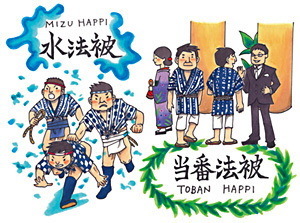Hakata Culture vol.12
The Yamakasa Happi

It’s no wonder that everyone who sees the Hakata Gion Yamakasa festival thinks it’s terrific. Older men clad in business suits who seem so tired of life, and young people too, seem to become suddenly transformed when they don the happi coat. More than the loincloth, the hand towels whose colors and patterns denote different roles, the geta and tabi, and the kakinawa hanging from the waist, the happi coat makes the difference for the men.
Two types of happi coats are used. One is called the mizu happi, and is worn by those who actually pull the floats. The name is derived from the drenching of water they take to cool them off during their labors. The mizu happi is white with the name of the wearer’s group and neighborhood dyed into the fabric. It’s fastened tightly in the front to enable others to quickly grasp the back of the coat of those who have fallen and set them on their feet again.
The other is the stylish toban happi, also called the naga happi, with an eye-catching design placed on kurume kasuri. This is proper attire throughout the town from June 1 until the end of the festival. It is a distinctive Hakata trait that it can be worn at weddings, funerals and in hotel lobbies during this period. There are now about 52 varieties of mizu happi and about 54 types of toban happi. Despite their number, however, they are a relatively new development. Judging from pictures dating back to the Edo period (1603-1868), the men were bare-chested and wore only loincloths. As more people followed Western customs during the Meiji period, however, some thought the practice should be ended because it was unsightly to run around half-naked. The problem was even discussed in the local assembly.
Another problem that arose in 1898 was the height of the floats. The decorative floats, which were also pulled through the streets, were so tall they frequently cut overhead electrical wires. The Hakatans solved these problems by reducing the height of the floats, separating them into those pulled through the streets and those used for decoration, and having the men wear happi coats. The Yamakasa has changed with the times. Don’t you think the use of fashion and design to effect those changes has made the event more attractive?
A public relations manager
Kimiyo Sasaki
カッコ良い!山笠の法被
博多祗園山笠を見たすべての人は「この祭り、カッコ良い!」と思うはずです。スーツ姿では疲れた雰囲気を醸し出すおじさんたちや若者が、あの山笠姿に変身するとがぜん、カッコ良く見えます。締め込み姿に役割によって色や柄が違う手ぬぐい、地下足袋、腰に下げたかき縄、その中でもひときわ男たちをカッコ良く見せているのが法被です。
法被には2種類あり、実際に山をかくときに着ているのは「水法被」、勢い水を浴びることからこの名前が付きました。水法被は白地に流ながれや町名の名前をデザイン化して染められており、前を固く結ぶことになっています。転んだときでも法被をつかんで起こしやすいから。もう一つは粋な「当番法被」、長法被とも呼ばれ、久留米絣にこれまたデザインがカッコ良いのです。6月1日から山笠終了までこの当番法被が正装となり、期間中は冠婚葬祭すべてこれでOK、ホテルのロビーでもこの格好なのですが、これがまた博多らしい風景となっています。
現在、水法被は約52種類、当番法被は約54種類。実はこの法被の歴史は意外にも新しいのです。江戸時代の絵図などを見ていると締め込み姿で上半身は裸、これが明治時代になり西洋を見習えという風潮の中、半裸で走り回るのは見苦しいから中止せよと議会で問題になったとか。明治31年(1898)のこと、もう一つ問題になったのが、山笠の高さです。それまでは飾り山の高さをかいていたのですが、たびたび電線を切ってもめていたようです。これらの問題を博多っこたちは、山笠の高さを低くしてかき山と飾り山に分け、半裸が見苦しいなら法被を着ようということで、問題を乗り切りました。
山笠も時代とともに変革してきたのです。それもカッコ良く、ファッション、デザインという手法を使って変革してきたと思いませんか?
福岡市広報課長 佐々木 喜美代

